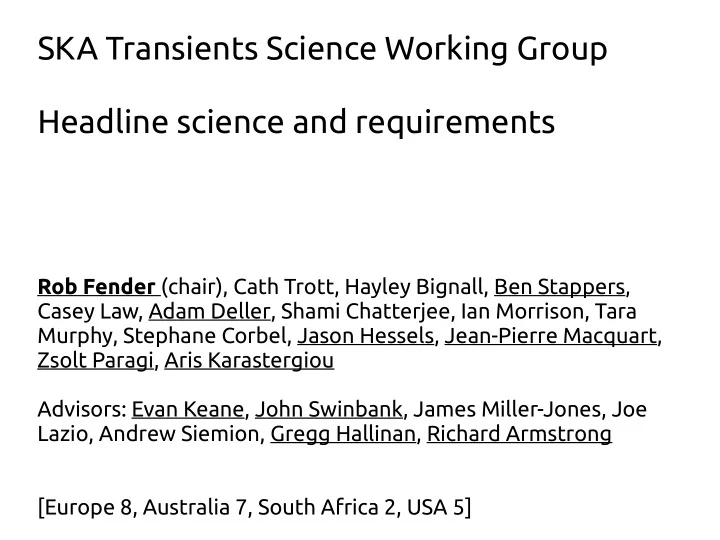

SKA Transients Science Working Group Headline science and requirements Rob Fender (chair), Cath Trott, Hayley Bignall, Ben Stappers, Casey Law, Adam Deller, Shami Chatterjee, Ian Morrison, Tara Murphy, Stephane Corbel, Jason Hessels, Jean-Pierre Macquart, Zsolt Paragi, Aris Karastergiou Advisors: Evan Keane, John Swinbank, James Miller-Jones, Joe Lazio, Andrew Siemion, Gregg Hallinan, Richard Armstrong [Europe 8, Australia 7, South Africa 2, USA 5]
Transients and the SKA “Key Science Programmes” – are the original KSPs still valid points of reference? – Transients relates to parts of several of the original KSPs but should not be bundled merely as “exploration of the unknown” which seems to be a 'soft' design consideration – Astronet , UK Astronomy advisory panels, etc. all list Extreme Astrophysics as one of their top priorities – LOFAR, ASKAP, MeerKAT all approved Transients as Key Science
Two flavours of radio transients Incoherent synchrotron emission Coherent emission Relatively slow variability Relatively fast variability Brightness temperature limited High brightness temperature Associated with all explosive events Often highly polarised Sometimes very steep spectra Early branch in classifjcation pipelines Find these (mostly) in images Find these (mostly) in time series
Transients science Extreme environments and Astrophysics Testing relativity Lighthouses to huge distances All of these are 'killer science' if Nature/Science and national reviews are anything to go by
Pulsars : discovered as unexpected astrophysical transients GRBs (and their afterglows): largest cosmic explosions, visible to ~EoR, huge multiwavelength coordinated efort → 100s of Nature papers... Supernovae : Ia → cosmology. Optical surveys fjnding many new classes.
Coherent bursts FRBs: potentially unmatched as cosmic probes of the IGM Bursts from extrasolar planets?
Synchrotron emission Tracer of all astrophysical explosions: Calorimeter of relativistic kinetic feedback Probe of black hole populations
Maximise The Science Concept of Operations Section 2.6 “ The primary success metric for the SKA Observatory will be the signifjcance of its role in making fundamental scientifjc discoveries and facilitating overall scientifjc progress, expressed as high impact, peer-reviewed scientifjc papers using SKA data.A8 Additional success metrics such as the total number of users, etc., will also be developed and measured. ” -- all of these metrics will be greatly enhanced by commensal analysis of data and public release of alerts.
Making the SKA a 21 st century telescope: commensal searches and rapid response
Predicted rates Will the transients be rare, manageable or a deluge? LSST – a SKA contemporary – anticipates fjnding N transients / night
Predicted rates: GHz We know there are interesting transients here, but rates not very well determined 1% of mJy-level sources at 1 GHz are signifjcantly (>25%) variable At 5 GHz, tidal disruption evens may dominate (Frail et al. 2012)
For ~10 uJy r.m.s. expect about 1 transient per deg -2 → 0.1-10 per day with SKA 1 -Mid Frail et al. (2012)
Predicted rates: GHz Assuming commensal searches, otherwise order of magnitude smaller Probably of order 1 interesting new image-plane transient per day (plus a whole bunch of sources you're monitoring, plus a stack of AGN variability) Only really tested to ~mJy sensitivity CHILES will test to ~uJy depth (albeit in a narrow fjeld)
Predicted rates: MHz Less clear Transients reported, and pulsars of course detected Best image-plane rate estimates probably from LOFAR (still being established) FRBs: could be a lot, depends on spectrum and scattering
Results from LOFAR search for transients in NCP MSSS observations at 60 MHz Stewart et al. (in prep)
Stewart et al. (in prep)
Detection not limit (maybe) → one transient per 1000 deg 2 at a r.m.s. of 100 mJy → 0.1-10 per day with SKA 1 -Low Stewart et al. (in prep)
Predicted rates: MHz Assuming commensal searches, otherwise order of magnitude smaller Minimum 1 interesting new transient image-plane per day, could be considerably higher Only really tested to ~ 100 mJy sensitivity Better LOFAR data will test to ~1 mJy FRB rate should be > 1 day -1 (caveat spectrum)
Multiwavelength Don't forget to consider the environment SKA will be operating in 6 transients/night LSST → 10 ATHENA+ → transients LIGO → transients? CTA* → transients (* CTA is being designed for very rapid slew response to external alerts, despite there being far fewer UHE transients than radio transients!)
Synergies with other major facilities 2015 2020 2025 2030 ATHENA+ LSST/E-ELT CTA LOFAR SKA phase I SKA phase 2
NASA / LIGO / LSST / CTA / ++ all strongly support the push for commensal transient searches with SKA and confjrm their communities would make use of them
Summary Wide range of science Potential for the biggest discoveries: maximise your fjeld of view (beams) and time on sky (commensal searches, transient bufer boards) Desperately needs not to have commensal searches and robotic designed out → headline request from Transients SWG Design an ambitious 21 st century telescope!
Recommend
More recommend